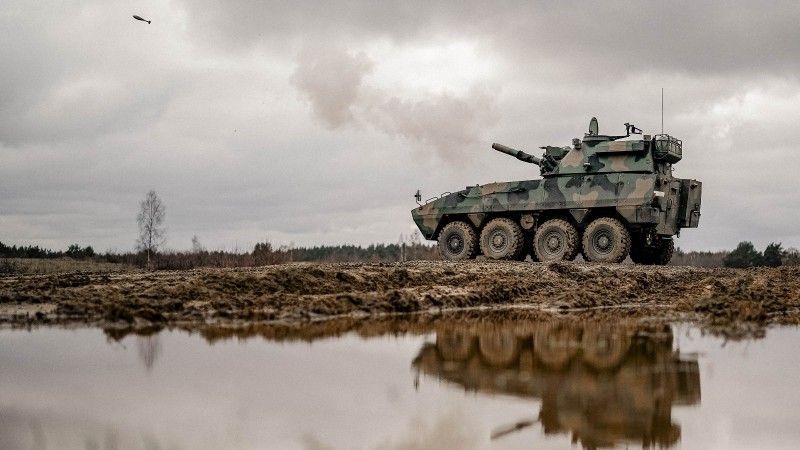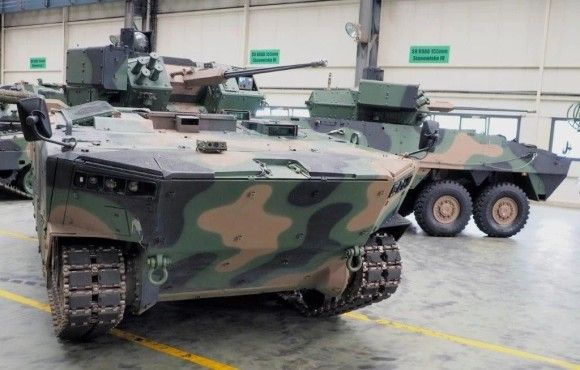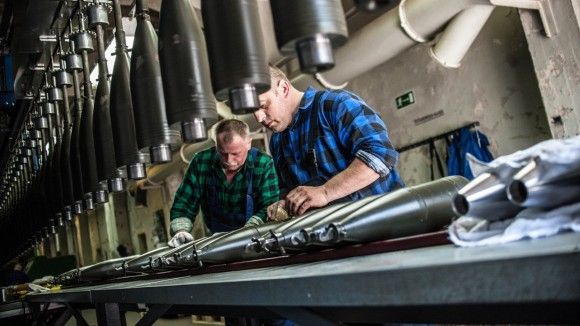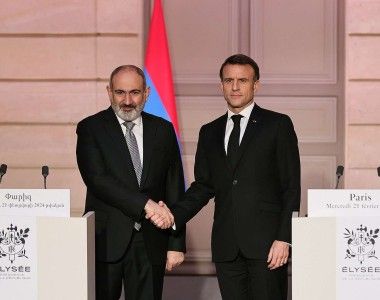Where is PLN 13 billion for the Polish Defence Industry?

Photo. st. szer. Daniel Brzozowski / DG RSZ / X
Even though the former leadership of the Ministry of State Assets, and the PGZ Group’s management board, were both announcing that several billion zlotys may be allocated to boosting the defence industry’s output, less than PLN 1.5 bn. has been transferred for that purpose so far, Defence24.pl found out. There is no clear knowledge available regarding the remainder of that amount, and no clear framework exists for a long-term financing plan, although the PGZ Group is declaring that needs as such exist. Uncertainty or even protests have been a theme in rumours circulated in the defence industry. Meanwhile, the military is awaiting deliveries of new equipment.
Following the start of a full-scale war in Ukraine, Poland decided to accelerate and expand its defence procurement efforts. Initially, procurement made abroad was the key focus, given the tempo of deliveries. At the same time, plans were made to boost domestic manufacturing, both via domestic R&D projects (such as Borsuk IFV), and licensing agreements as well (like the K2PL main battle tanks). However, for that assumption to become reality, extra capital needs to be provided to the domestic defence industry. For years, those facilities have not been involved in manufacturing efforts at this scale. They need investment funds, and funds to establish relevant capabilities.
As Defence24.pl found out, so far only a minor portion of the declared funding of several billion zlotys was provided to the parties involved. Last year the means coming from the Capital Investments Fund were allocated to support for two projects, one at HSW, and one at ZM Bumar-Łabędy.
The Government’s Information Centre responded to an inquiry made by Defence24.pl. The first project concerns the agreement signed on 7th June, on the investment that would boost HSW S.A.’s potential through the expansion and modernization of manufacturing facilities, and takeover of Autosan Sp. z o.o. business and LiuGong Dressta Machinery Poland Sp. z o.o. Another project is known as „13th October 2023 Agreement valued at PLN 850 million - Implementation of an Investment Project by ZM „Bumar-Łabędy” S.A. (PGZ S.A. subsidiary), aimed at launching manufacturing of the Krab self-propelled gun-howitzers at the ZM „Bumar-Łabędy” S.A. facility”. The value of the agreement has been set at the level of PLN 1.45 billion.
Ambitious Plans
The declarations that had been made by the government and the PGZ Group management last year were far more ambitious. In March, Sebastian Chwałek, President at the PGZ Group at the time, told „Dziennik Gazeta Prawna” that talks on the provision of „several billion zlotys” are underway, involving the government, with the financing expected over a few years. Earlier on, in February, Prime Minister Mateusz Morawiecki announced that HSW would receive a capital boost in an amount exceeding PLN 1 billion. As the GIC response suggests, just one tranche of financing has been assigned so far.
Back in August 2023, Jacek Sasin, the Minister of State Assets at the time, said that solutions had been prepared that would make it possible to provide extra capital for the PGZ Group, in an amount of PLN 13 bn. „HSW S.A. received PLN 600 million. Further funds will also be provided to [Huta] Stalowa Wola and Bumar. 800 million zlotys are expected to be provided to launch a second production line for the Krab howitzers. The Ministry of State Assets has prepared legal solutions needed to provide extra PLN 13 bn. to PGZ, to boost the recovery in the defence industry, creating circumstances in which the Polish Armed Forces would be receiving weapons manufactured at domestic factories.”, he noted. The extra capital was to be used to boost the manufacturing of Polish weapons, like the Krab howitzers, Grot rifles, and Piorun MANPADS, or launch the license manufacturing of equipment procured in Korea, like the K2PL main battle tanks, or the K9PL howitzers. Later, Chwałek told Defence24.pl in an interview that PLN 13 bn. would be distributed across 3-4 years. Data obtained by Defence24.pl shows that a bit more than 10% of that amount was transferred in 2023.

Photo. Jerzy Reszczyński/Defence24.pl
We asked the Secretary of State at the Ministry of State Assets, Marcin Kulasek, to comment on that matter. Kulasek said that the possible extra capitalization, in a higher amount of up to PLN 13 bn. „clearly exists, nonetheless, the Ministry of State Assets does not yield direct legal tools that would make it possible to autonomously provide extra capital for the company, by raising the share capital through a payout of specific means. Different legal tools make it possible to support companies, like providing them with investment property, but in cases like that, the process itself needs to be initiated by the Companies themselves”.
It should be clarified then, how the extra capital is provided. “The financial means that are to be used to heighten the PGZ S.A.’s share capital came from the Capital Investments Funds supervised by the PM’s Office. The available information suggests that further requests for extra capital are being considered now.”
How to Find the Financing?
It turns out that the Ministry of State Assets has no direct funds that could be allocated to the provision of extra capital for the defence industry companies. After receiving a response from the Ministry, Defence24.pl asked the Polish PM’s Office about that and received information on the aforesaid tasks that have already been accomplished at HSW (PLN 600 million), and at Bumar (PLN 850 million). The Government’s Information Centre also clarified the matters, stating that the financial plan of the Capital Investments Funds is defined for calendar years, and without a sector-specific division, it has no long-term profile.
The GIC also stated that Sasin’s statement pertained to the “Reprivatization Fund, managed by the Minister of Finances, not the Capital Investments Fund”. Hence, Defence24.pl also submitted an inquiry to the Ministry of Finances. We will publish the relevant information, once it is received.

Photo. Zakłady Chemiczne "Nitro-Chem" S.A. w Bydgoszczy
Asked about other sources, Kulasek stressed that the Reprivatization Fund may be among the possible solutions here. He also noted that he did notice a disproportion between defence industry expenditure, and the funds allocated to defence procurement.
Potential extra capital should not focus solely on the CIF. It is just one of the available options here. Other options, like the Reprivatization Fund, managed by the Minister of Finances, can also be considered here. I would also like to note that the matter of large disproportion between the defence procurement expenditure, and the defence industry funding, is being diagnosed by the Ministry of State Assets, and we will be going to great lengths, working hand-in-hand with the Polish Ministry of Defence above all, to eliminate those disproportionate efforts where possible. One cannot expect that without long-term contracts, and a solid, certain order financing situation, the companies will be in possession of usually significant capital, needed for development. This must be a team effort. We all want Poland to be safe, and a strong defence industry is one of the pillars of national security.
Marcin Kulasek, Vice-Minister of State Assets
The Vice-Minister also noted that long-term contracts are key for the defence businesses. „For companies, a certain prospect of development and business is very important, which comes in the form of long-term contracts with certain financing, not only allowing the company to manufacture the products, boosting the manufacturing power, but also to get involved in intense work on R&D projects. The situation as such is becoming more common. The Polish Ministry of Defence, and the Armament Agency started to notice the actual benefits of contracts as such. One may have a look at circumstances in which companies like HSW S.A. or Fabryka Broni „Łucznik” Sp. z o. o. find themselves in - their condition also stems from long-term contracts”, he stressed.
Here, it is worth to define the context. The disproportion mentioned by the Vice-Minister of State Assets stems from the fact that until 2020-2021, the Polish defence procurement planning was spreading the acquisitions across longer timelines. Technical Modernization Plan worth more than PLN 500 bn. was adopted in 2019, with the most significant spending planned after 2030. The full-scale war beyond the Polish border accelerated the defence expenditure efforts. For instance, in 2020, the capital expenditure (also including construction investments, but being a good modernization spending indicator) was implemented at a level lower than PLN 17 bn. In 2023 the defence budget plan involved an amount of PLN 40 bn., and several more bn. in the Armed Forces Support Fund.

Photo. kpr. Sławomir Kozioł
Let us add that no similar acceleration was implemented for the defence industry (along with long-term instruments like the AFSF). Earlier on, the defence industry had not been solidifying its capabilities, since no large-scale orders were placed. The existing orders were distributed across a longer timeline, and they were made for an Army of four, not six divisions.
All of the circumstances above paint a dire picture, when it comes to the defence industry financials. Even if requests for extra capital are accepted at a scale similar to the preceding year, throughout 2024, this still will not be enough, with several billion zlotys needed to meet all of the requirements defined by different companies.
The fact that several billion zlotys are needed, and PLN 1.45 bn. was the provided financing, has been confirmed by PGZ, responding to our inquiry: dynamic and gradual increase of the state defence potential, including the quantitative and structural growth of the Polish Armed Forces, resulted in increased defence expenditure. The PGZ Group, as the baseline domestic partner in this process, is the recipient of some of the funds allocated to the technical modernization of the Armed Forces. This is confirmed by the transfer of CIF means to PGZ in 2023, to provide extra capital for ZM Bumar-Łabędy S.A., in the amount of PLN 850 million, and for HSW S.A., in the amount of PLN 600 million.
„At the time we estimate, that for the whole PGZ Capital Group, to pursue the modernization programmes (…) the financial support shall be provided at the level of several billion zlotys, across a couple of years. We would like to note that the implementation of investment so significant rapidly, allowing us to gradually increase the manufacturing capacity, requires decisions to be coordinated at the governmental levels. Approaching this matter like that would make it possible to create an investment programme, based upon solid fundaments, including The Technical Modernization Plan, developed and regularly updated by the Polish Ministry of Defence, ownership strategy for PGZ, developed and implemented by the Ministry of State Assets, and Ministry of Finances and PM’s Office, deciding on the sources on financing”, PGZ Group stressed.
Who is Responsible?
The process aimed at the provision of extra capital is managed by several departments: Ministry of State Assets (assessment of needs), Polish PM’s Office (managing the Capital Investments Fund, first-degree financing means, planned on an annual basis), and the Ministry of Finances (managing the Reprivatization Fund). This group should also include the Polish Ministry of Defence, responsible for the assessment of needs, and indication of what shall be delivered by the industry. No system was implemented, this or last year, that would create a long-term financing scheme for the defence industry. Without the ability to program the financing in the longer run (similarly as it happens in the case of the Armed Forces Support Fund), it would be very challenging to pursue large-scale investments. It would essentially be impossible. Here, a skilful organizational and legal approach is needed. The provision of extra capital means that the specific entity (like the Capital Investments Fund, FIK), allocates money needed by the Treasury to acquire shares, which entails specific consequences stemming from the commercial law and accounting regulations.
The convoluted nature of this matter is also emphasized by the fact that last year declarations were made by the Minister of State Assets, and now information on these issues is provided by several organs (including the Polish PM’s Office, and the Ministry of Finances). By the way, PGZ identified a need for the provision of extra capital of PLN 2 bn . as early as 2019 (a little more than PLN 3 billion, given the current prices). The growth is tied to the growth of the requirements expressed by the Armed Forces. No instruments allowing for scalability have been implemented here.

Photo. Polska Grupa Zbrojeniowa
Time is running out, and the needs remain broad. Let us recall that the framework agreements alone cover manufacturing of at least 500 K2PL main battle tanks, 1,400 UMPG platform vehicles (including more than a thousand Borsuk IFVs), 700 heavy IFVs, and several hundred new APCs - all is to be done domestically, in Poland. These tasks would be assigned to HSW, WZM Poznań, or Rosomak S.A. And this is just one area. Other domains include the manufacturing of missiles (for the Narew Programme), munitions (Mesko), or radars needed for the air defence systems (PIT-RADWAR). The funds managed by the PM’s Office in the National Munitions Reserve programme have been left untouched. The agreement on that matter, concluded by the Armament Agency in December 2023, was related to procurement financed via the budget of the Polish Ministry of Defence.
What do these delays mean for the Armament Industry and the Polish state? It is not a secret that the financial situation does not permit for autonomous pursuit of investment so broad, as the assumed boost of manufacturing capability is a major quantitative and qualitative leap, compared to the previous years and the potential at hand. The financial standing has been one of the reasons for which the Polish munitions suppliers were asking for just PLN 11 million, within the framework of the EU ASAP programme (with 2 million received in the end). This situation is worrying for the defence companies. The HCP facility, which recently became a part of the PGZ Group, is a good example here. The Poznan-based company is to play a key role in manufacturing the K2PL main battle tanks, a process led by WZM Poznań.
After protests at HCP, an interministerial group meeting was organized, involving Vice-Minister of Defence Paweł Bejda, Deputy Head of the Ministry of State Assets Marcin Kulasek, and Vice-Minister of Development and Technology Jacek Tomczak, as well as Agata Sobczyk, Governor of the Greater Poland Voivodeship, representatives of the ARP (Industry Development Agency), and ARP Operator entities. During the meeting, a development strategy for the facility was outlined, with the future orders potentially placed by the Polish Ministry of Defence being taken into account. No information on specific programmes was released, but it is almost certain that it pertains to the K2PL project - this is the assumption behind the industrial agreements signed last year. For that process to be launched, investments are needed that would allow WZM and HCP to establish relevant capabilities.
The extra capital for WZM was expected to be provided in late February and early March last year. This has not happened yet. No extra funds have been received by HCP. The situation was described by Sebastian Chwałek, President of the PGZ Group at the time as follows, in September last year: „The expansion of WZM’s capabilities, as the leader of this project, is one thing, but we also need to remember that the Cegielski company is in its final stages of entering the PGZ Group structure. This means that we are preparing investments for the manufacturing of the K2PL main battle tank. The first request tied to the establishment of the potential will be pursued soon”.
A Gordian Knot of sorts has been formed. To secure long-term procurement contracts involving the Armament Agency, the defence industry companies need to showcase, to a certain extent, the capability to deliver. The procurement money cannot be used to establish potential from the ground up. From the PGZ’s standpoint, it would be desirable to sign long-term agreements, to establish planning and financing stability (involving banks for instance). Provision of extra capital may be a valid solution here - shares being acquired by the Treasury in exchange for major funds being provided to companies to strengthen their finances and pursue further investments. No proper mechanism for the provision of extra capital at that scale exists, despite declarations made last year.
The situation related to the extra capital for the defence companies calls for immediate action. It shall be one of the priorities for the current government, as the predecessors were unable to deliver on the ambitious declaration they had made. If the „Gordian Knot” is not resolved soon, the Armed Forces, with a heightened budget, but in line with the law, allocated to different matters, as extra capital is handled by different ministries, will yet again face a dilemma: buy off the shelf or wait. This should be avoided at all costs, given the current international situation.
Jakub Palowski, Jędrzej Graf




